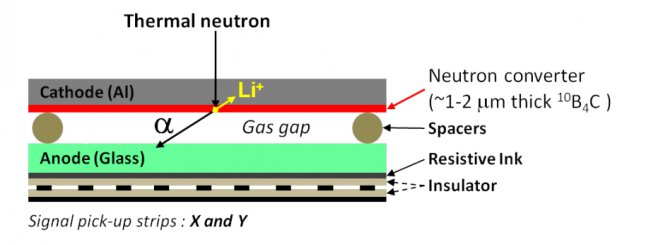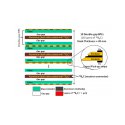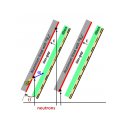Portugal: RPCs for Neutrons - How they work
November 2018
Standard Resistive Plate Chambers (RPCs) consist of two electrode (an anode and a cathode) plates, both made from a resistive material and separated by a thin layer of gas called a “gas-gap”. When a charged particle enters the gas-gap it can ionize the gas molecules to create electron-ion pairs. Due to the electric field, the ions travel towards the cathode and the electrons towards the anode, inducing signals on the pickup electrodes. The moving electrons are also subject to a Townsend avalanche process which amplify the signals. Ultimately, this acquired data provides information such as time-of-flight (TOF) and position telling us where and when an event occurred.
As mentioned in our previous article, at least one of the electrodes needs to be coated with a thin neutron converter layer of 10B4C to make it sensitive to thermal neutrons. When the neutrons hit the converter layer, a fission reaction with the 10B isotope causes the production of 7Li, 4He charged particles:

For thinner converter layers, these charged particles can migrate into the gas-gap and start the ionization process mentioned above. In principle, the converter layer can be deposited on the cathode or the anode, or both. The cathode is a good choice for simplicity of detector design and spatial resolution. Another benefit is that all the charged particles generated by neutron capture in 10B will start ionizing in the vicinity of the cathode, which eventually enables higher spatial resolution.
Improving 10B RPCs
When designing 10B RPCs, it is important to consider what will affect the performance of the detector. The results of simulations and feasibility studies with detector prototypes already realized in the framework of the SINE2020 project, have revealed that:
- Good adhesion properties of the converter layer to the RPC plates is required.
- The thickness of the converter layers need to be optimized according to the neutron wavelength (or distributions of wavelength) for which the detector is designed to improve the chance of both neutron capture and migration of fission products into the gas-gap.
- A thin gas-gap requires a lower polarisation voltage and minimises the horizontal component of the particle's range that improves spatial resolution. The gas-gap width needs to be uniform throughout.
- The materials to hold the signal pickup strip arrays must be chosen carefully in order to minimise neutron absorption and neutron scattering effects.
Adhesion of the converter layer
Normally, Resistive Plate Chambers have both electrodes made from a material with high volume resistivity (typically in the range 109 – 1013 Ωcm). This gives rise to the chamber’s name. However, it is also possible to design RPCs where one of the electrodes is metallic and the other resistive without losing its spark protection mechanism. In this design, named Hybrid RPC, the two orthoganal arrays of metallic signal pickup strips (X and Y on the diagram below) that in a standard RPC sit one behind each resistive electrode now have to be arranged to both sit behind the highly resistive anode plate which requires a more intricate design.

The advantage of using a hybrid design, though, is that a metallic substrate can form the cathode and allow a well-established 10B4C deposition technique to be used to make a high quality and stable converter layer.
Finding a balance
Unfortunately, the maximum detection efficiency achieved with a single layer of a solid neutron converter such as 10B4C, is only about 5% which is unsatisfactory compared to the more commonly used, but increasingly difficult to source, 3He (100%). This is because the migration of the fission products into the gas-gap through the 10B4C layer is stopped as they have a short range of only a few μms in solids, limiting the probability of a neutron to be detected. To increase the chance that a fission product successfully reaches the gas-gap, the solid converter layers need to be thinner but this will then reduce the neutron path length through the material, thus reducing the probability of neutron capture.
A couple of options could help to solve the challenge of low detection efficiency for the solid converter layers.
1. Use multilayer and multigap RPC designs with thin converter layers but providing several opportunities for neutron capture within the same device (e.g. Multilayer of double-gap RPCs, conceptual diagram below). For the multigap design, the converter layers must have a surface resistivity in the range 10-7 – 10-9 Ω.cm so they do not shield the induction of signals in the pickup strips.
2. Reducing the angle between the direction of incidence of the neutrons and the converter layer. The neutrons would then pass through more material and the path would be lengthened (e.g. Inclined RPC, conceptual diagram below) but keeping the converter layer thinner, and thus a high probability for the fission products to enter the gas-gap and be detected.


Luís Margato and his team at LIP Coimbra have been working on different 10B RPC designs and improvements. In our next article you can find out what results have been obtained so far.
Reference: L. M. S. Margato, A. Morozov, Boron-10 lined RPCs for sub-millimeter resolution thermal neutron detectors: Conceptual design and performance considerations
Acknowledgements: Luis Margato, LIP
Back to The Road to the ESS
Other articles: Resistive Plate Chambers, RPCs: Results so far, LIP, Detectors




